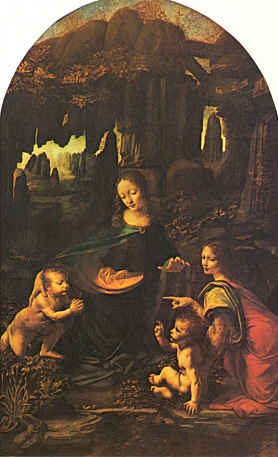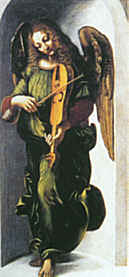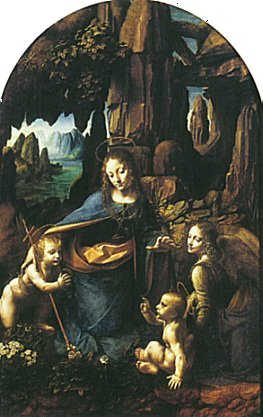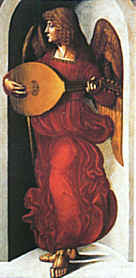|
On the 25th April 1483, Leonardo was contracted to deliver an altarpiece which would decorate the chapel of the Immacolata at the church of San Francesco Grande in Milan. At the same time Evangelista De Predis was assigned the task of carrying out the gilding, colouring and retouching with his brother Ambrogio to do side panels. Giacomo del Maino was commissioned to carve the framework and once finished the pieces would resemble a miniature temple. Leonardo's contract had a very short deadline which required the painting be delivered before December 8th, the feast of the Immaculate Conception, (this strongly suggests that the artists already had a cartoon prepared), but as was typical of him he failed to comply; this piece then became the source of two lengthy lawsuits which lasted for the many, many years.
Two versions of this painting exist, one at the Louvre in Paris and the second held by the National Gallery in London. Experts have studied both closely and consider the Louvre version to be entirely by Leonardo, while the National Gallery version is still the source of some debate. The favoured suggestion is that de Predis and Leonardo collaborated on this painting after he failed to meet his contractual obligations. Others think Leonardo was less involved in the second version and apart from a few touches, he simply oversaw de Predis. The Louvre painting may have been given by Leonardo to King Louis XII of France in gratitude for settling the law suit between those who commissioned the works and the painters; this would have created the need for a second artwork. Critics continue to take issue with which is the earlier version of Virgin of the Rocks and there is no proof either way. It appears that the style of the Louvre version belongs more to the 1480s and this painting was probably completed early in 1490. The London painting is a more mature work and assuming it is the later version, dates to around 1506.
The contract was very complicated and carefully designed to ensure the monks received precisely the picture they wanted: Item, Our Lady is the centre: her mantle shall be of gold brocade and ultramarine blue. Item, her skirt shall be of gold brocade over crimson, in oil, varnished with a fine lacquer...Item, God the Father: his gown shall be of gold brocade and ultramarine blue. Item, the angels shall be gilded and their pleated skirts outlined in oil, in the Greek manner. Item, the mountains and rocks shall be worked in oil, in a colourful manner.... Some changes were made to this description, St. John was introduced while an angel was removed. The side panels required four angels on each, singing and playing harps. Documents recently found show Leonardo's painting was eventually set in place on 18th August 1508, with the final payment for it being made in October of the same year. The Virgin or Madonna of the Rocks is the first work that Leonardo executed in Milan. It addresses the theme of the Immaculate Conception; this being the belief that the Christ child was conceived without original sin on Mary's part. This was a hotly debated topic in Leonardo's day and he was required to convey the purity radiating from the Virgin. In both paintings she was depicted as flat-chested and sitting in a cavern surrounded by phallic rocks and womb images. The setting was perfect for the chapel as it was built over catacombs. The paintings illustrate a popular story of the time. It is that of Jesus meeting an infant John the Baptist, who is in the care of the angel Uriel. Both are on the run to evade Herod's massacre of innocents. As John pays homage to Jesus he is blessed and the Baptism prophesied; this explains the pool in the foreground of the Louvre version. The plants in Leonardo's works are interesting as they were painted directly from nature during a time when most artists simply copied from the books of herbalists. Leonardo would carefully choose plants for their symbolic value. In the Louvre version of the Virgin of the Rocks, Aquilega, or columbine (dove plants) are beside the Virgin's face; these symbolise the Holy Spirit. Stains on the St. John's wort suggest a martyr's blood, the creeper Cymbalaria symbolises constancy and virtue. Heart-shaped leaves represent love and virtue; sword-shaped leaves, the sword of sorrow which was to pierce Mary's heart and the palm leaves are a symbol of victory. The Louvre version, considered to be wholly by Leonardo, is set in the autumn. The original sketches showed the angel as very feminine; this was changed in the final painting where the angel can be seen as either male or female. It was first mentioned as being in the royal collection at Fontainebleau in 1625.
Virgin
of the Rocks Virgin of the Rocks in London's National Gallery displays a number of changes from the Louvre piece. It brings the viewer closer to the figures, is much bluer and has an air of flowing waters. Other new or changed elements include St. John's cross of reeds; the hand of the angel which no longer points at St. John; the halos and the lighter drapery. Both the halos and the cross were a later addition done by an unknown artist. Portions of the painting are slightly unfinished, the left-hand of the angel being one area. It is also likely that the foreground was intended to be contain a pool similar to that of the Louvre version. The 'plastic' look of this painting almost immediately led scholars to consider it a collaboration. Areas to compare are the rocks which seem badly lit, and the flesh of the children which is flat looking. This version remained in the chapel until 1781; it was then taken to the hospital of Santa Caterina in Milan. Collectors went to great lengths to obtain Leonardo's works, no matter how small. In 1875 this panel was purchased by the Scottish painter, Gavin Hamilton, who took it from Italy to London, then sold it to the Marquis of Landsdown. It passed into the hands of the Earl of Suffolk, finally entering the National Gallery in 1880. The two side panels of the de Predis brothers joined it in 1898; these depict the musician angels. All three paintings are now displayed together and appear as they would have in the chapel. The dispute over fees and the legal battles with the monks is thought to have been regarding the London copy only. Leonardo and Ambrogio -- Evangelista having died in 1490 -- had sent an appeal for extra funding, pointing out that not only had the project required in the contract been completed, but that the frame alone had absorbed almost all of the entire eight hundred lire fee which had initially been agreed on. In terms of payment they had actually only received one hundred of the twelve hundred lire that were asking. As a result they requested that the "oil painting of Our Lady" be withdrawn, so they could consider selling tit to other interested buyers. This request was refused and in 1503 Ambrogio tried once again, this time petitioning Louis XII of France, but Leonardo was no longer in Milan and the case was deferred. Things were finally settled on 27th April, 1506. It was determined that the work was, in fact, unfinished with the result that Leonardo was not paid for the first painting, it then being forfeited to the artist. He agreed to do a second work -- or to have another artist do one on his behalf -- and to deliver it on time. The deadline was be two years and for this he would receive half of the additional payment he had asked for the first painting, the sum of two hundred lire. The subject of the Immaculate Conception was a popular one of the day and was taken up again and again by pupils of the Leonardo school. |
|





